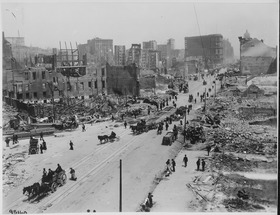Mid-Market | |
|---|---|
 View of Mid-Market, following the 1906 San Francisco earthquake | |
| Coordinates: 37°46′50″N 122°24′45″W / 37.780518°N 122.412534°W | |
| Country | |
| State | |
| City-county | San Francisco |
| Area | |
| • Total | 0.17 km2 (0.067 sq mi) |
| Population | |
| • Total | 2,170 |
| • Density | 13,000/km2 (32,000/sq mi) |
| Economics | |
| • Median income | $102,321 |
| Time zone | UTC−8 (Pacific) |
| • Summer (DST) | UTC−7 (PDT) |
| ZIP Codes | 94103 |
| Area codes | 415 and 628 |
Market Street Theatre and Loft District | |
California Historical Landmark No. N1436 | |
 | |
| Location | roughly bounded by 982-1112 Market Street (NW side), 973-1105 Market Street (SW side). One Jones Street and 1-35 Taylor Street, San Francisco, California, U.S. |
|---|---|
| Area | 13.1 acres (5.3 ha) |
| Architect | James Rupert Miller, et. al. |
| Architectural style | Chicago school |
| NRHP reference No. | 86000729[1] |
| CHISL No. | N1436 |
| Significant dates | |
| Added to NRHP | April 10, 1986[1] |
| Delisted CHISL | April 10, 1986 |
Mid-Market (also Central Market, and Market Street Theatre and Loft District) is a neighborhood, historic district and development area in San Francisco, California. The neighborhood is bounded by Market Street to the north, 5th Street to the east, Mission Street to the south, and Van Ness Avenue to the west. There are many theaters in the district, most of which began as vaudeville theaters, include the Warfield and Golden Gate.[2]
In 1906, Mid-Market was decimated by the 1906 San Francisco earthquake, and over the next century, Mid-Market would rebuild itself. In the 21st century, Mid-Market has served as a major economic area for San Francisco. Mid-Market has contained the headquarters for Twitter, Block, Reddit, Zendesk, Uber, and Dolby, as well as historic buildings, such as the Old San Francisco Mint, the James R. Browning United States Courthouse, and the San Francisco Federal Building.
Mid-Market is part of California's 11th congressional district, as of 2021.
The "Market Street Theatre and Loft District" was listed on the National Register of Historic Places on April 10, 1986, for the architecture, and its events and commerce history;[2] and is listed as a California Historical Landmark since 1986.[3] It has twenty contributing buildings and covers 13.1 acres (5.3 ha).
- ^ a b "National Register Information System". National Register of Historic Places. National Park Service. November 2, 2013.
- ^ a b "National Register of Historic Places Inventory/Nomination: Market Street Theatre and Loft District". National Park Service. Retrieved January 16, 2024. With accompanying pictures
- ^ "Market Street Theatre And Loft District". California Office of Historic Preservation (OHP). State of California.


